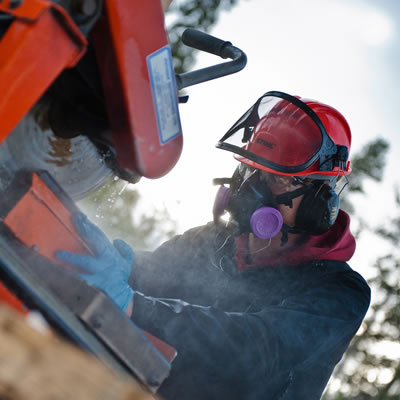Building a culture of safety is a slow process

The safety situation in the mineral exploration industry has greatly improved since PDAC and AME BC conducted their first survey in 2005. — Photo cou
The safety situation in the mineral exploration industry has greatly improved since PDAC and AME BC conducted their first survey in 2005. — Photo courtesy Brian Kornichuk/AME BC
The Canadian exploration industry is safer and more safety-conscious than it used to be, but it still needs to pull up its socks if it's going to get even better.
That's the message of the most recent state-of-the-industry safety report conducted by the Prospectors and Developers Association of Canada (PDAC) and the Association for Mineral Exploration British Columbia (AME BC). The survey, which was conducted last year, covers 2013.
First, the good news:
According to the survey, 93 per cent of respondents reported having a health and safety program in 2013. That's a record, up from 85 per cent of respondents in 2012. And 89 per cent of respondents always had an emergency response plan for each site in 2013, up from 86 per cent in 2012. The lost workday incident frequency in 2013 was 1.09 per 200,000 hours, approximately one-half the rate for all Canadian industries as reported by the Association of Workers Compensation Boards of Canada.
On the other hand, only 146 organizations active in mineral exploration in Canada reported on their safety practices in 2013, down from 156 in 2012. And health and safety is a standing agenda item at just 62 per cent of respondents’ board of directors' meetings.
Be that as it may, the safety situation in the mineral exploration industry has greatly improved since PDAC and AME BC conducted their first survey in 2005. At that time, building a culture of safety in the mineral exploration sector was difficult. Back then, the industry was very macho and safety was looked down on as the preoccupation of sissies. “In 2005, I formed the PDAC health and safety committee,” said Bill Mercer, chairman of the association's health and safety committee. “I believed that a national survey of health and safety was a critical step to getting basic knowledge of what was happening across the country. I knew AME BC was already doing this for B.C. and Yukon, so it seemed only sensible to approach it and joint-venture the idea, by taking its survey and making it national.”
Mercer said the annual report summarizes “what the statistics are telling us: what kinds of accidents are happening, how many of them and what to do about it.” Mercer said the associations also use the survey to tell them if their health and safety manuals are up-to-date. “I give talks at conferences, in universities to the students, and so on, about health and safety in the field," Mercer said. “I also use the health and safety statistics—if they are not good—to beat down on my colleagues in the industry to improve performance.”
Mercer said the mineral exploration and mining industries are becoming more safety-conscious. “I think that there has been a dramatic change (during) the past 20 or 30 years in how safety is viewed and addressed,” he said. “A good example is the exploration drilling industry, which has drills that are far safer than in the past. Some have as many as three automatic shutoffs instead of only one, and they have far more serious guarding around rotating parts. And many drills have automatic rod handling, because rod handling caused many, many finger injuries—often amputations—in the past.”
Mercer said PDAC faces some challenges in getting its members to take safety seriously. “The smaller companies find implementing all the measures expensive and time-consuming,” he said. Smaller drill companies probably don’t invest as much money in safer drills. And the boards of directors of small companies probably have less expertise in health and safety than the boards of larger organizations.”
Mercer said the biggest health and safety issue facing the mining and mineral exploration industries is fatalities at work. “That is what we need to eliminate,” he said. “But one thing that has become clear to me in the past year or so—our statistics are telling us that when there is a downturn in the industry, the rate of accidents falls.” Mercer said he thinks this means that when there is a downturn, the people in the field are safer because they are more experienced. “When we have booms in exploration, a lot of people who have little experience are hired, and they are more likely to be involved in an accident,” he said. “This is a really important subject.”
PDAC and AME BC safety workshops
PDAC has run a one-day health and safety course at its annual convention in Toronto for the past four or five years, said Bill Mercer, chairman of the association's health and safety committee.
“It has been one of the highest rated short courses at the convention,” he said. “It's been a good group, but, unfortunately, the number of attendees has been small. We have also—but not this last year—run wilderness first aid courses.”
Every year AME BC offers two courses in workplace safety, said Jonathan Buchanan, director of communications and public affairs and staff support for the association's environment, health and safety committee: the Exploration Safety for Management and the Introduction to Exploration Safety workshops.
“The management workshop is for senior management and project managers,” said Buchanan. “Our goal is to foster responsible and adaptive safety leadership. Effective safety leaders are the building blocks of a strong culture that strives for everyday safety and zero harm.”
The introductory course is aimed at recently graduated geoscientists, field assistants and project geologists. Course content includes interactive field safety scenarios and strategies for dealing with them; the regulatory environment and what to expect from employers; and recommended traversing equipment for mountain and bush environments.
PDAC has run a one-day health and safety course at its annual convention in Toronto for the past four or five years, said Bill Mercer, chairman of the association's health and safety committee.
“It has been one of the highest rated short courses at the convention,” he said. “It's been a good group, but, unfortunately, the number of attendees has been small. We have also—but not this last year—run wilderness first aid courses.”
Every year AME BC offers two courses in workplace safety, said Jonathan Buchanan, director of communications and public affairs and staff support for the association's environment, health and safety committee: the Exploration Safety for Management and the Introduction to Exploration Safety workshops.
“The management workshop is for senior management and project managers,” said Buchanan. “Our goal is to foster responsible and adaptive safety leadership. Effective safety leaders are the building blocks of a strong culture that strives for everyday safety and zero harm.”
The introductory course is aimed at recently graduated geoscientists, field assistants and project geologists. Course content includes interactive field safety scenarios and strategies for dealing with them; the regulatory environment and what to expect from employers; and recommended traversing equipment for mountain and bush environments.




